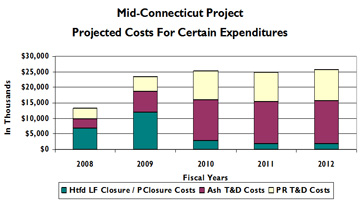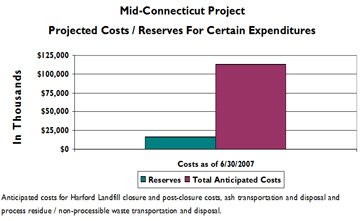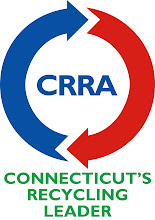For the most part, reporters have done a good job of trying to understand this case and then distill it into the limited space they have to tell their stories. One of the beauties of a blog like this is that we’re freed of space restrictions, so we can fully explain some of the points touched on briefly in the news coverage.
The main point that needs more detailed explanation today is the relationship between this lawsuit and our disposal fee -– the price we charge municipalities and haulers for disposing of trash they collect. More to the point, we’d like to explain how the $35.9 million award would be used to benefit those 70 cities and towns.
CRRA is completely self-funded. Our trash-to-energy projects have to cover all their costs with revenue from just two sources -– electric sales and trash disposal fees. Our electric revenues are fixed with multi-year contracts, so the only variable we can adjust from year to year is the disposal fee.
When our costs drop, our disposal fee drops. When our costs increase, we must increase our disposal fee to cover those costs. And in fiscal year 2009 (which starts July 1, 2008), our Mid-Connecticut Project’s costs are going to increase substantially due to the closure of the Hartford landfill. Take a look at this graph:

What you see here is a breakdown of costs associated with closing the Hartford landfill. The Mid-Connecticut Project has used the Hartford landfill since the 1980s, so the Project, and by extension its towns, is responsible for closing it properly. By December 2008, the Hartford landfill will reach its permitted capacity, so CRRA will have to close it with a geosynthetic cap, then pay for 30 years of post-closure monitoring and maintenance. Our latest figures show the closure and post-closure costs will run between $40 million and $45 million. That is represented by the turquoise segments of the bars on this graph.
Currently, the landfill accepts ash, which is a by-product of trash-to-energy, and non-processible waste – material that can’t be burned to generate electricity. When the landfill closes, we’ll have to truck all that material to another site, most likely a privately-owned landfill in another state, and those costs are represented by the violet and cream-colored segments of the bars on the graph.
Right now, all those costs add up to about $112 million.
So what does this have to do with New Hartford v. CRRA? The money awarded to the Mid-Connecticut Project towns -– and it’s important to note none of the other CRRA projects was impacted at all by either the Enron bankruptcy or this litigation -– was money CRRA had been holding in reserve to help pay for those costs. But with that $35.9 million gone (until we prevail in our appeal, which we expect to do) we have almost nothing in the bank. This graph compares our reserves to those future costs:

You may be wondering what kind of difference $35.9 million would make against $112 million in costs. CRRA still is pursuing lawsuits against 11 banks involved in the Enron transaction, and we believe those actions will bring us tens of millions more dollars.
Those lawsuits, by the way, are a primary reason for our appealing the New Hartford ruling. That ruling contains language which would seriously damage our cases against those banks, so if we didn’t appeal we’d be leaving tens of millions of dollars on the table, all of which would be used to absorb these increasing costs.
The bottom line is this: the towns will receive money through this lawsuit, but they’ll be paying it back in higher disposal fees. If we still had those reserves, they’d be used to offset these cost increases.
